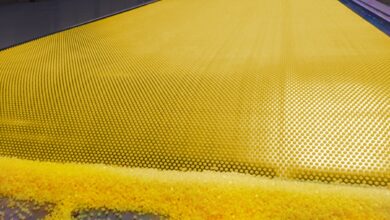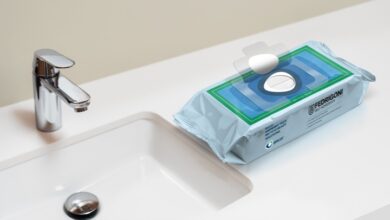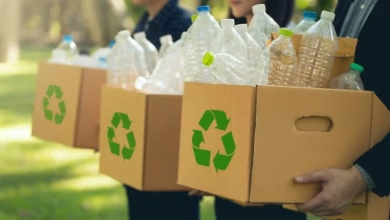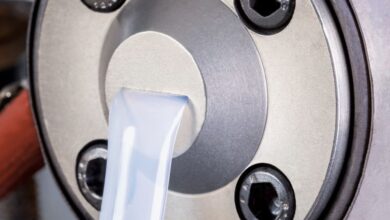
Iranpolymer/Baspar The global water-soluble packaging market size was at USD 3,020 million in 2022 to hit approximately USD 5,340 million by 2032, registered at 5.9% CAGR projected between 2023 and 2032.
Report Highlights: Important Revelation
– Transformative shift towards eco-friendly solutions with water-soluble packaging
– A paradigm shift towards sustainable water-soluble packaging
– Transforming water-soluble packaging with polymer solutions
– Revolutionizing agricultural packaging with different industrial sectors
– North America takes the helm in the global water-soluble market by 31.42%
– Europe takes the lead, Asia emerges in the water-soluble packaging market
Transformative Shift Towards Eco-Friendly Solutions with Water-Soluble Packaging
The global water-soluble packaging market is expected to reach around USD 4,460 million by 2029. Water-soluble packaging is a packaging material that can disintegrate or dissolve in water; it is also known as biodegradable packaging. These materials are designed to break down when they encounter water, leaving little to no residue behind. This type of packaging is often used for various purposes, including environmental sustainability and convenience.
By 2025, the total amount of solid trash is anticipated to reach 2.2 billion tonnes yearly. Utilizing packaging materials that are neither renewable nor biodegradable might harm the environment. Additionally, as consumers’ knowledge of environmental and health concerns has grown over the past few decades, there has been a rapid demand for safe, healthful foods that use as little chemical, synthetic, or plastic-based input as possible.
As industries increasingly prioritize sustainability, water-soluble packaging emerges as a versatile ally in pursuing eco-friendly alternatives. Its adaptability and potential to revolutionize packaging practices position it as a catalyst for change. By addressing the environmental impact of packaging materials, water-soluble packaging represents a beacon of hope for a more sustainable and responsible future, where convenience and ecological consciousness coexist harmoniously in the products.
Water-Soluble Packaging Market Trends
- Increased Use of Biodegradable Materials – The water-soluble packaging market is experiencing a notable transition towards employing biodegradable and compostable materials, responding to heightened environmental consciousness. Manufacturers actively explore innovative materials like polysaccharide-protein-based films, align with eco-friendly principles, and meet evolving consumer preferences for sustainable packaging solutions.
- Focus on Agricultural Solutions – Water-soluble packaging is gaining prominence in agriculture, notably for fertilizers and agrochemicals. This packaging dissolves upon application, mitigating the environmental footprint linked to conventional packaging. Adopting such innovative solutions reflects a commitment to sustainable practices within the agricultural sector.
- Expanding Applications in Healthcare – Water-soluble packaging is increasingly used in the healthcare sector, specifically for pharmaceuticals and medical products. This trend is propelled by the imperative for convenient and secure packaging disposal within healthcare settings. Adopting such packaging solutions underscores a commitment to safety, hygiene, and environmentally responsible practices in the healthcare industry.
-
Technological Advancement in Film Production – Continuous research and development initiatives drive notable technological progress in water-soluble film production. These advancements encompass film strength, barrier properties, and dissolution characteristics. The resulting packaging is becoming more resilient and versatile, catering to diverse sectors, including healthcare, chemicals, food, and beverage. This evolution underscores a commitment to innovation and heightened performance standards.
North America Takes the Helm in the Global Water-Soluble Market
Due to environmental concerns, numerous cities in the US, alongside states like California and New York, have implemented bans on single-use plastics. This shift towards sustainability has catalyzed the growth of the biodegradable plastics market, with North America as the leading region in the water-soluble packaging market.
The establishment of advanced standards and certification systems underscores the maturity of the water-soluble plastics market in North America. Notable benchmarks include the Euthe American Society for Testing and Materials (ASTM) standards in the US and ISO standards sanctioned by the International Organization for Standardization.
Europe is positioned as a burgeoning leader in the biodegradable plastics market, yet the transformative momentum is notably expanding into Asia, with China and India at its forefront. This shift is propelled by stringent plastic restriction policies, making Asia, especially China and India, pivotal hubs for the surge in demand for biodegradable plastics. The growth is fundamentally linked to robust regulations curbing plastic usage and an intensified emphasis on sustainable practices in response to environmental concerns. As these countries confront the adverse effects of plastic, the biodegradable plastics market is witnessing substantial momentum, opening noteworthy avenues for manufacturers and investors keen on tapping into the evolving landscape of sustainable solutions in the plastics industry.
A Paradigm Shift Towards Sustainable Water-Soluble Packaging
Water-soluble packaging is emerging as a transformative solution with widespread applications in food, healthcare, agriculture, and consumer products. With a surge in consumer awareness regarding environmental concerns and an increasing focus on corporate social responsibility, industries actively seek eco-friendly alternatives. Water-soluble packaging addresses these concerns by offering a sustainable option that aligns with evolving consumer values.
Regulations addressing plastic waste are becoming more stringent, prompting industries to reevaluate their packaging strategies. Water-soluble packaging provides an avenue for compliance with these regulations while contributing to reducing plastic waste. It positions itself as a proactive response to the evolving regulatory landscape, ensuring businesses stay ahead of environmental mandates.
Transforming Water-Soluble Packaging with Polymer Solutions
In water-soluble packaging, the polymer segment is a pivotal component, harnessing the transformative potential of polymers that dissolve in water. This innovative approach provides a sustainable alternative to conventional packaging materials and propels the expansion of the water-soluble market by virtue of its versatile applications.
Water-soluble polymers are central in developing packaging materials that dissolve upon contact with water. Among the noteworthy polymers in this domain are Polyvinyl Alcohol (PVA), Polyethylene Oxide (PEO), and starch-based polymers. These polymers exhibit unique characteristics that make them well-suited for various applications, contributing to the burgeoning popularity of water-soluble packaging.
Revolutionizing Agricultural Packaging with different Industrial Sectors
Chemicals employed in agriculture pose significant risks to the environment and human health due to their inherent toxicity. As a result, there is a growing emphasis on the materials used in agricultural packaging. Traditional agricultural packaging, typically involving glass bottles for liquid chemicals, presents several drawbacks. These include the risk of breakage leading to toxic leaks, substantial chemical waste from leftover residues, and environmental contamination when improperly discarded.
Addressing these challenges, Polyvinyl Alcohol (PVA) packaging films and bags have emerged as a transformative solution. PVA’s unique physical properties and biodegradability have propelled its popularity in fertilizer and pesticide packaging. Unlike conventional materials, PVA minimizes the risk of leakage, reduces chemical waste, and provides an eco-friendly alternative, aligning with the increasing demand for sustainable agriculture practices. This shift towards PVA packaging signifies a crucial step in mitigating the long-term environmental impact of traditional agricultural packaging methods. In conventional dyeing, plastic buckets or standard plastic bags for depositing dyestuff lead to several operational challenges. The used plastic bags result in a significant accumulation of chemical waste, incurring substantial disposal costs. Moreover, the need for ample space to accommodate these plastic buckets contributes to heightened cleaning expenses. Additionally, residues in both buckets and PE bags compromise the accuracy of the requested dyestuff weight, impacting operational precision.
industrysourcing






